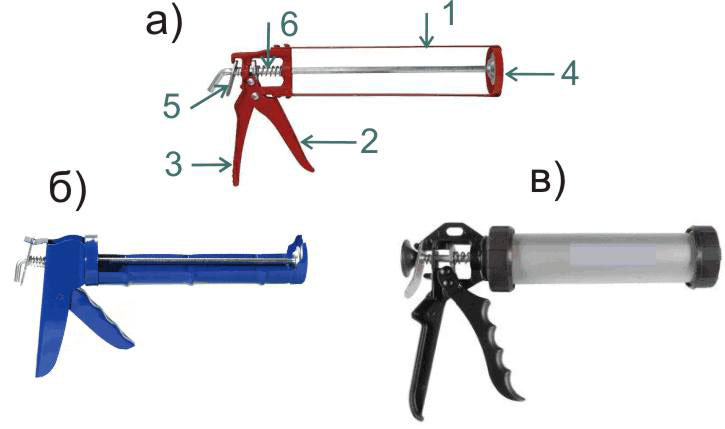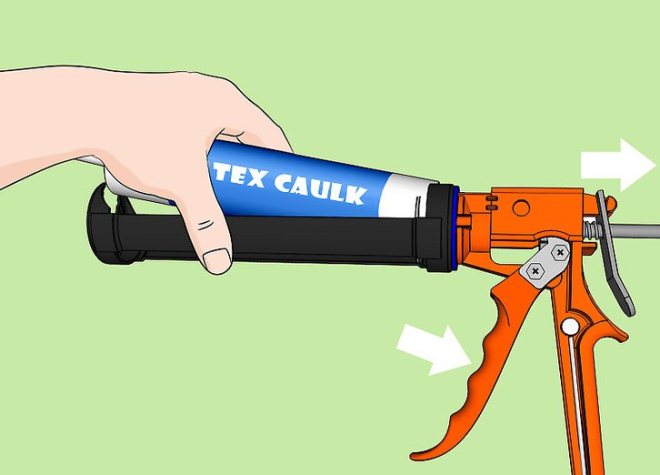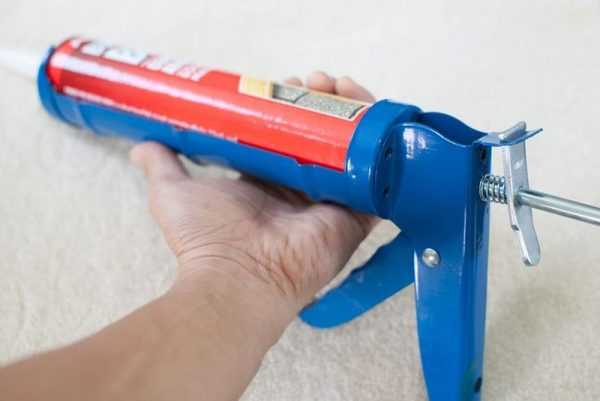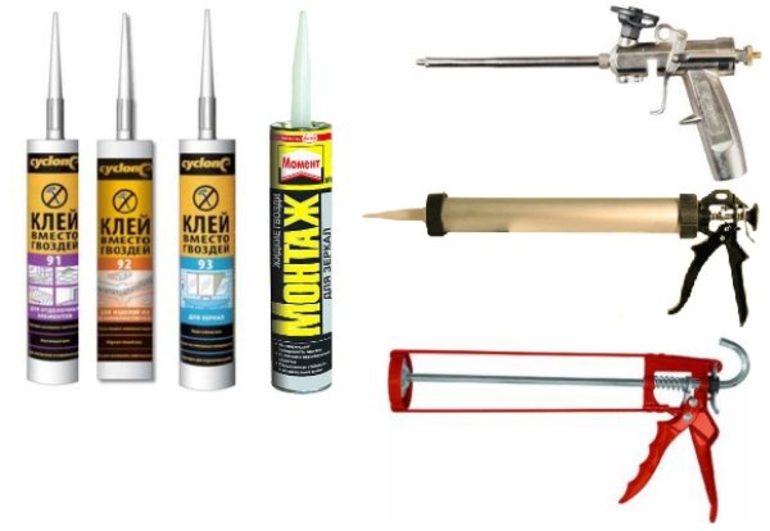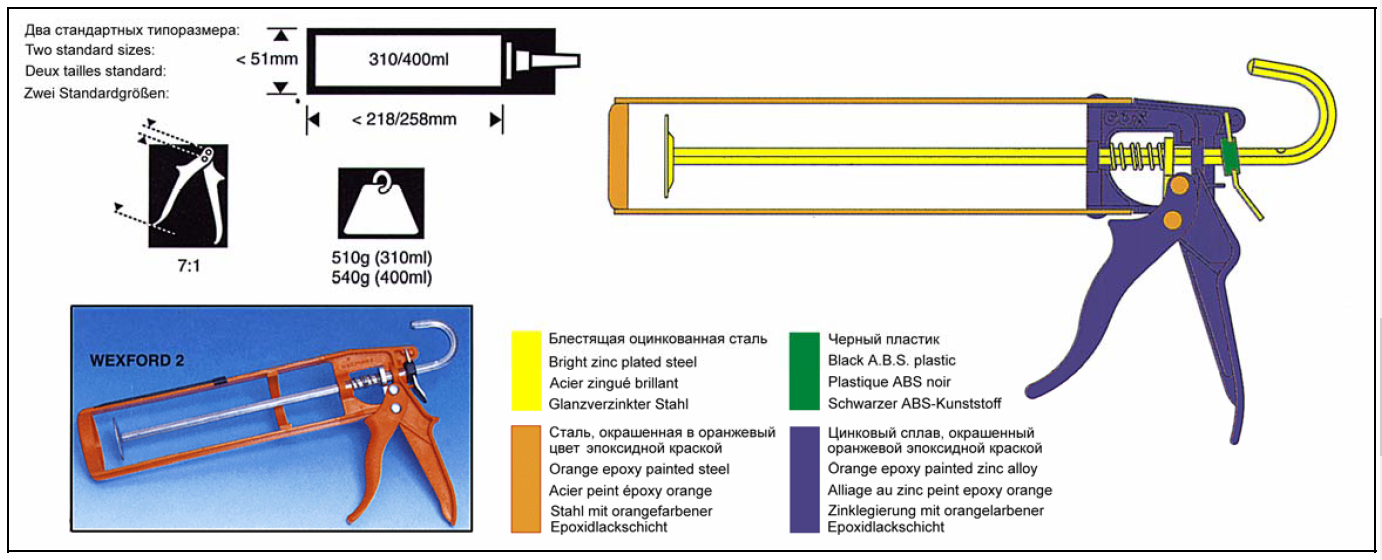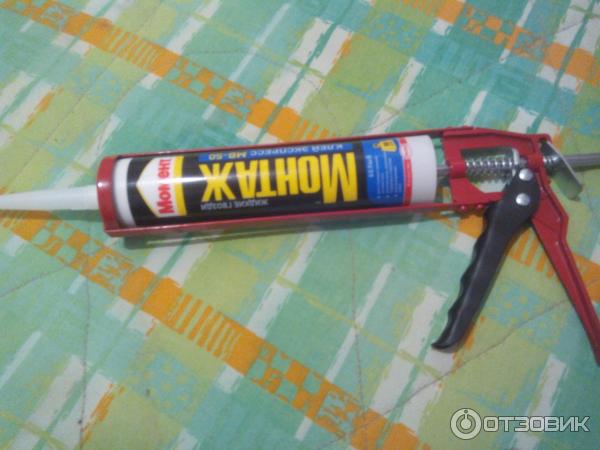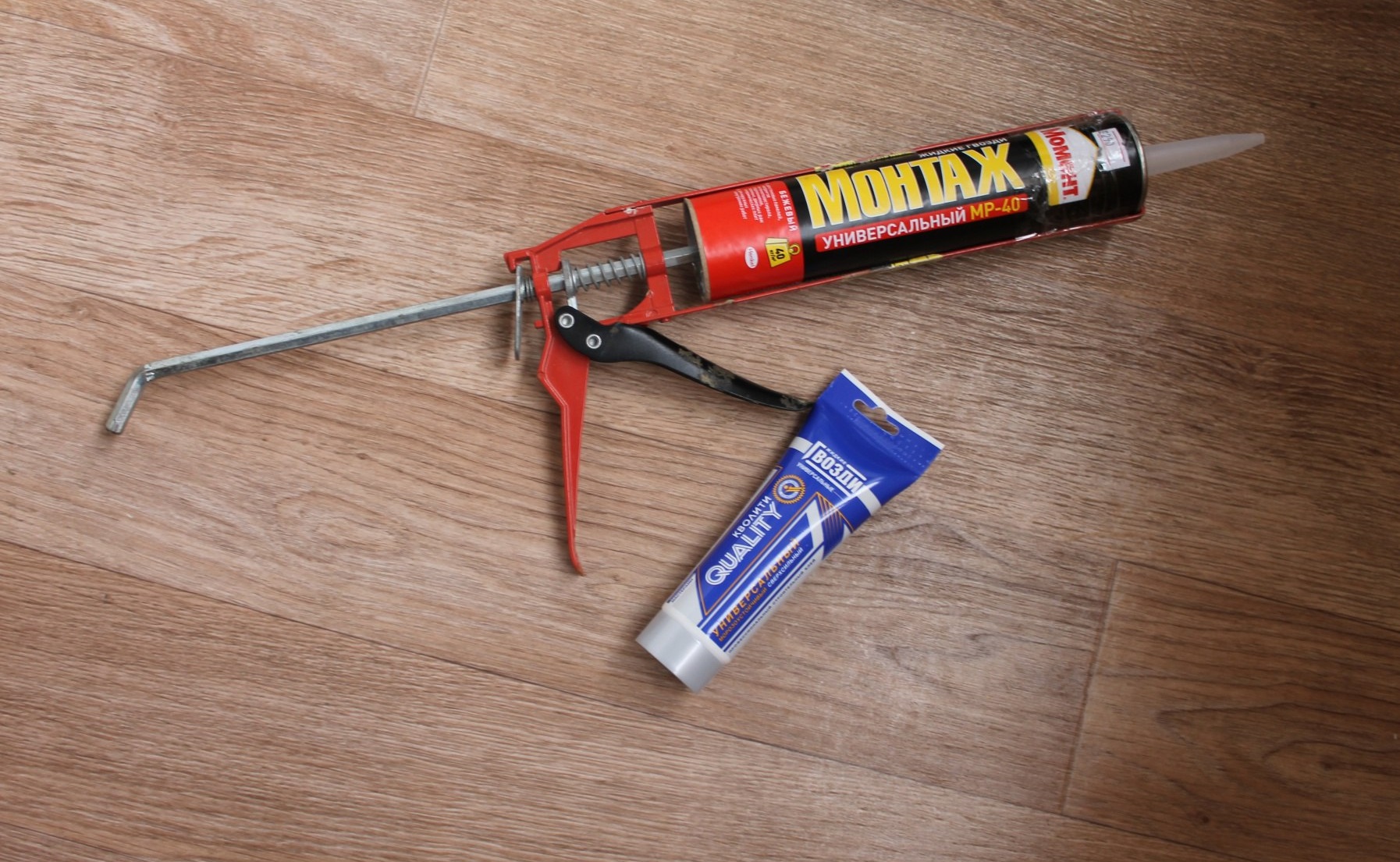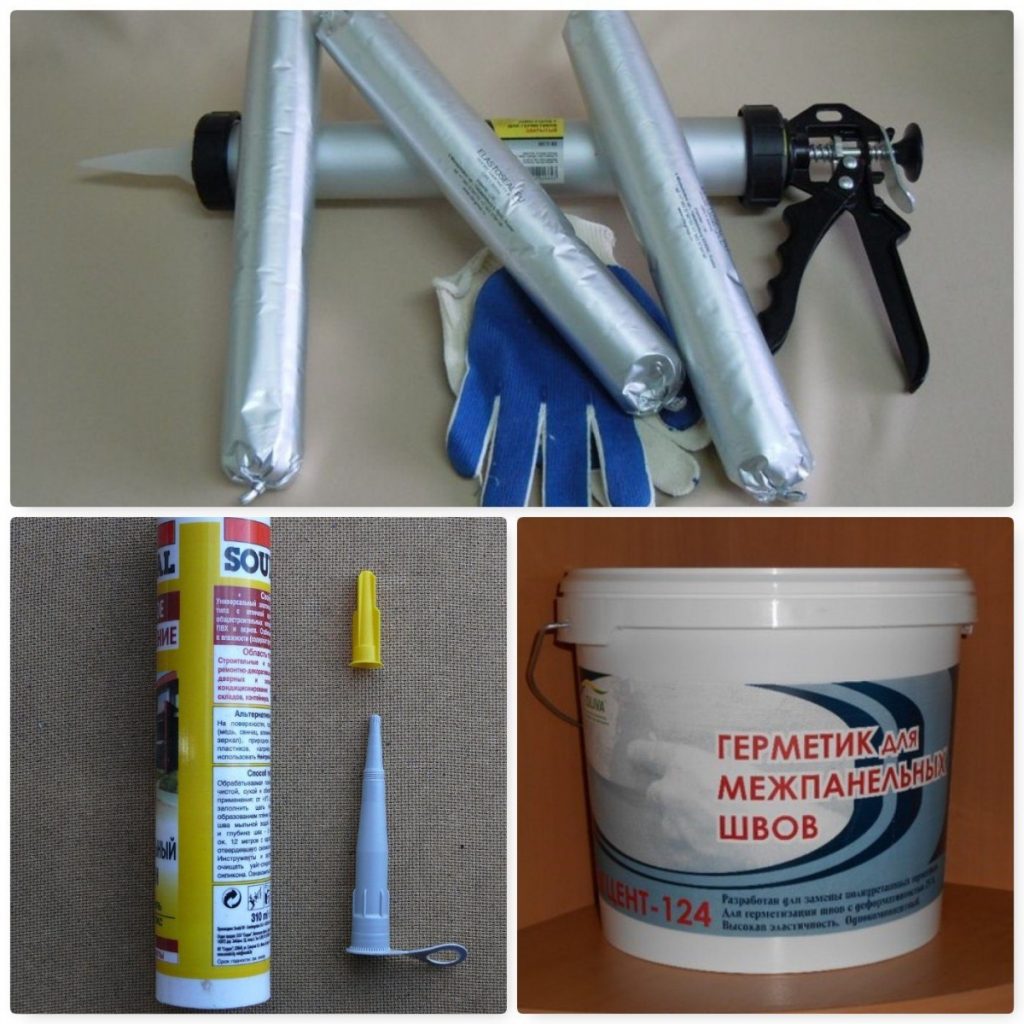Construction of assembly guns
Correct use of the gun makes it possible not only to save foam, but also to do the job efficiently, without the slightest flaw. The device of different models is almost the same. Their construction is quite simple. The tool has:
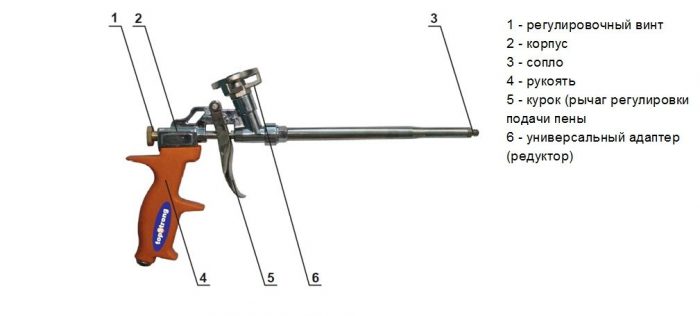
- adapter (reducer): this is a threaded adapter, a cylinder is screwed into it;
- the trigger is a trigger; when you press it, the foam "shoots out";
- an adjusting screw, it is used to meter out the material output;
- nozzle - a tip that creates the required sealant pressure;
- a handle designed for comfortable use;
- barrel - a cylinder with a channel for polyurethane foam;
- a needle rod located in the barrel.
The adapter, called a gear, contains a spring and a ball: these parts require cleaning almost constantly. The adjusting screw, which is responsible for the feed rate of the sealant and its amount, is handled like this: if it is screwed in to the end, then the feed is completely blocked, when screwed tight, the foam is heavier. The gasket screw next to the trigger prevents the compound from getting on it.
Instructions for use
Before starting work, you need to open the package with liquid nails and the gun itself, carefully read the instructions. It is imperative to check the expiration date of the glue: if it has expired, then such a product is not suitable for installation. Water-based formulations should be used only at a temperature of +5 degrees and above. Liquid nails with solvents can be used even at negative air temperatures.
Work rules
In order for the adhesion of the composition to the surface not to decrease, a number of preparatory measures must be taken. All dirt, dust, debris are removed from the base, they are rid of the remnants of the old, snapping paint and varnish coating. For degreasing, wipe the base with alcohol, acetone or a special degreaser. Too porous materials are treated with a primer for 2 layers. Smooth, shiny surfaces, on the other hand, are sanded to increase traction on liquid nails.
Before inserting the cartridge with glue into the gun, it is important to make sure that it fits exactly in size (it is better to take measurements before purchasing). If the gun is old, it is inspected for the presence of dried drops of glue, sealant, if necessary, wipe them with a solvent or scrub
After that, the tube is loaded into the pistol in this way:
- part of the plug is removed, the extension nose is screwed onto the thread;
- cap the tip of the extension cord;
- pull the rod towards themselves, freeing up space for liquid nails;
- insert the tube into the body, move the rod to the bottom so that the disk rests tightly on the piston;
- if the gun begins to warp (this happens with low quality models), they wrap it with construction tape, electrical tape or wire.
Working with a pistol
The glue feed can be continuous or intermittent. In the first case, a solid line is formed, and the trigger of the pistol for this purpose is pressed constantly, with the same effort. Also, the adhesive can be applied in the form of a snake or mesh, which is ideal for fixing ceramic tiles.
Application of liquid nails with a snake
For the second method, a point application of the agent or its distribution in strips of the desired length is carried out. This method is more popular, as it allows you to use the product more economically. In addition, too many liquid nails will cause them to dry slowly.
After distributing the composition on the surface, proceed as follows:
- connect the parts to be glued together;
- squeeze them tightly, making an effort;
- hold the elements for a minute by hand or with clamps, or under pressure;
- remove the surplus of the crawled composition;
- leave the surface unused until completely dry (about a day).
Fixing the parts to be glued with clamps
Application of liquid nails without a gun
It happens that the pistol is not at hand, so you have to apply the chosen agent without his participation. It would be inappropriate to buy a device for one-time gluing of small parts or applying a couple of small seams: all work can be done manually. The experts advise you to use one of the options below:
- Take the stopper from a 5 liter plastic bottle, make sure it covers most of the bottom of the cartridge. Place it on a suitable sized piece of wood or hammer handle. With the help of such a device, press on the bottom of the tube so that the composition begins to protrude from it. If you handle it inaccurately, the package may be skewed or the sides will be damaged. It is not worth using a block without a cork - the pressure on the bottom should be uniform.
- If the liquid nail package is made of a soft material, it can be pierced for use. It is better to make a puncture in the area of the bottom or where it can then be sealed with electrical tape without any problems. After a hole appears through it, you need to squeeze out a little glue and spread it over the surface with a narrow spatula. This method is rather inconvenient, as the composition yield is difficult to control.
Liquid nails in hand extrude packaging
- The easiest way to apply the product without a gun is to purchase liquid nails in a hand-squeeze package right away. It has a cork and a comfortable thin spout, with which it is easy to make the seam even, continuous. If liquid nails will be applied into the seam, it is advisable to cover the edges of the two products with masking tape in advance. The tape should be removed immediately after the completion of the work, without waiting for the composition to set.
Liquid nails Moment: how to use it correctly
Today, building glue called "liquid nails" is used to join a variety of surfaces. The substance is used in construction, finishing and renovation works.
The classic composition of nails is based on synthetic rubber and a special kind of clay mined in Texas. The addition of titanium dioxide gives the adhesive a white color. To reduce the cost, chalk is used (instead of expensive clay), which consequently deteriorates the quality.
The toluene included in the composition is responsible for adhesion, but slows down drying. To shorten this time, acetone is added to the composition of the material.
Sequence of gluing parts
To release the glue from the tube, you need to press the pistol handle with frequent hand movements.
The head of a threaded tube is cut off with a sharp knife or the membrane is punched with a sharp object. A conical tip is screwed onto the head, the cap is removed from it. The tip of the tip is cut off at a 45 ° angle and the cap is put back on. The adhesive cartridge is ready to use.
The piston rod must be loosened before inserting the cartridge into the gun. The tube is inserted into the device, by pressing the trigger, the stem is clamped until it stops. The cap is removable. By frequent pressing on the handle, the glue is applied to the surface in an even strip or dotted fragments. For gluing large surfaces, a mesh or snake is applied.
The surfaces to be glued are pressed down and, if necessary, fixed with additional devices. Individual flat parts can be pressed down with a press. Some types of glue set within 1-2 minutes.
The total adhesion time of the parts is usually 12-24 hours.
Consideration should be given to the area of the surfaces prepared for bonding. Do not cover large surfaces to be glued completely with glue and do not apply excess glue. This will increase the setting time of the compound.For gluing decorative parts, the cut is made with the smallest indent from the end of the cone.
Any excess glue that has come out is wiped off with a cloth soaked in solvent. Glue stains remaining on wood parts can be removed with a special cleaner. The glued structure can be operated no earlier than in a day.
In any large-scale repair, we resort to using assembly glue, however, not everyone knows how to use this composition correctly. It is likely that each of us will realize how to open the mounting glue
, but not everyone knows how to insert it into a pistol. Adhesive joints in repair work are simply irreplaceable when fixing laminate or parquet boards, wall and ceiling panels, plinths, stucco moldings, and various decorations.
Modern adhesives sold as "liquid nails" are cartridges of 400 to 310 g, there are also more economical options - 200 g, which are suitable for small jobs. Any product indicates how to use the composition correctly and for which materials it is best suited, but not all manufacturers indicate how to use a glue nailer
.
Open the assembly glue correctly:
- So, first you need to strictly follow the instructions on the cartridge label: the nozzle should be cut at an angle of 45 ° to the mark.
- The membrane is opened with a needle or other sharp object.
- Then we install the nozzle on the opened cartridge and fill it into the assembly gun - weaken the working rod of the tool, insert the tube into the niche and clamp the rod all the way, the main thing is not to create strong tension in the tube.
In general, nothing complicated, now you know how to insert assembly glue into a gun
... The glue is applied in dotted drops, the process is associated with driving in ordinary nails. For strength of adhesion, continuous application of the adhesive composition to the surface is not required; for fastening heavy parts, the composition is applied in a thin strip.
To remove the cartridge of liquid nails from the gun, you must press the locking tab and, while holding it, pull the rod towards you as far as it will go. Then we move the cylinder forward a little and take it out of the pistol.
Please note that after completing work with liquid nails, it is recommended to immediately clean your hands and tools from the adhesive, otherwise, after drying, it will be quite difficult to do this. Mounting adhesive on an organic basis is best washed off with acetone, white spirit and toluene, rinse water-soluble compounds well enough with water
If you did not manage to figure it out, how to use a liquid nail gun
or you think that you can cope on your own and do not plan to purchase this tool, we recommend that you study the instructions for working with the composition in detail. For a small amount of renovation work, this is quite possible.
How to use liquid nails without a gun?
If you open a new tube with assembly glue, you can squeeze out the contents with ease by pressing your finger, otherwise, you need a stick, for example, the handle of a hammer. The main thing is accuracy, you cannot turn over the cork that closes the balloon, otherwise the entire adhesive will spread and the tube can be thrown away.
Some people don't quite understand how to use liquid nails.
This is not surprising, since this device is relatively new on the building materials market.
This article explains how to use liquid nails and which ones are better to choose.
How to remove the solution
Even when working with a gun, there is a possibility that the glue will get on furniture, hands or other elements in the room. In this case, you will need to urgently remove it. For this, it is advisable to use a solvent, but this option is only suitable for prompt removal of fresh glue.

If the adhesive is already frozen, then only a special cleaner is used to remove it, and you can also use a scraper, but it can damage the coating.
A liquid nail gun, the instructions for use of which are indicated above, are considered an excellent choice if you need to use a high-quality adhesive for joining various specific surfaces. It greatly simplifies this procedure, and also ensures that the solution does not get on other objects in the room where the work is carried out.
When carrying out repair and construction, finishing, installation work, as well as work on decorating a room, building glue is used, better known in everyday life as liquid nails - Liquid Nails. This special construction adhesive is made on the basis of polymers and rubber and is supplied to the market in tubes of various capacities or in cylindrical cartridges (tubes). For the convenience of working with cartridges, it is customary to use a special construction (assembly) gun for liquid nails, which is designed for dosed application of glue to the glued surfaces.
Liquid nails will help in tiling
Such a gun is used to work with various sealants, which are packaged in similar special tubes with a standard volume of 310 ml. This tool got its name because of the principle of operation - the adhesive is applied by pressing the trigger, therefore it is compared with the weapon of the same name. Although the process of applying glue itself is more like the work of a syringe.
When choosing liquid nails, study the instructions on the package to find out if this building glue is suitable for those types of surfaces that are to be glued.
Like similar construction tools, assembly guns are divided into two main types: household (mechanical) and professional (pneumatic and battery).
It is customary to use professional ones for applying all kinds of sealants, and three types of mechanical pistols are used to work with liquid nails.
An inexpensive type of liquid nail gun - half body. Such pistols are short-lived, not convenient enough to work with. The stand for a cartridge with construction glue is, as it were, cut in half and during operation the tube often skews, which interferes with the smooth movement of the stem.
For a home craftsman, there is a simple solution to this problem - the tube is tightly fixed in the pistol body using wide adhesive tape. Tape the tube, placed in the body, closer to the handle, with tape. At the same time, they protect the branded sticker, which is located on the case. There is a manufacturer's warranty for such working tools, and in order for the gun, if necessary, to be returned under warranty, it is advisable not to damage this sticker.
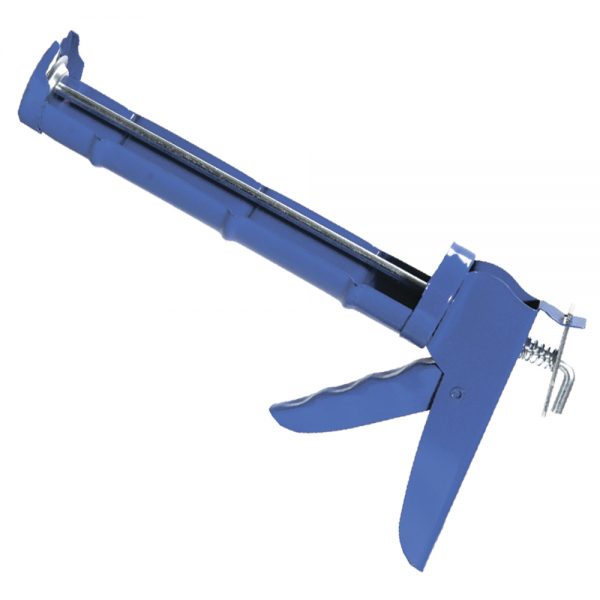
The next type of assembly gun is the most popular among buyers and is called skeletal. It is slightly more expensive than a half-case, but more reliably holds the cartridge with liquid nails, due to which the glue flows more smoothly. However, here too, scotch tape is used to tightly fasten the tube, since the cases for inexpensive pistols are made of aluminum, which does not provide sufficient rigidity.

The most convenient for working with liquid nails is a tubular (syringe) gun. It tightly fixes the cartridge with glue or sealant, and serves not only for working with tubes, but also with folium packages, which are used for packing some types of sealants.

Safety rules and finishing work with liquid nails
It should be remembered that the composition of liquid nails can be toxic and flammable. This applies to materials made from artificial polymers. Such components have a pronounced chemical odor. It is necessary to work with such materials in a special mask, gloves and a room with forced ventilation.
Water-soluble mixtures are more environmentally friendly.But they dissolve under constant exposure to moisture, and are not recommended for adhesion of metal structures.
- Before starting work, make sure the integrity of the packing with LH.
- Store mounting materials away from heat sources, at room temperature, and out of the reach of children.
- If using power tools to dispense glue, check that the voltage is correct and that the insulation is intact.
- If the composition comes into contact with exposed skin or eyes, rinse immediately with running water.
After the work is completed:
- Close the container tightly with the lid, otherwise the solution will quickly harden and the package can be thrown away.
- If using special tools, disassemble and wipe with adhesive remover.
- Store the equipment disassembled.
- If the excess glue does not have time to dry, they are simply removed with a clean cloth.
- The hardened residues can be removed with special liquids for dissolving repair mixtures.
- If you are not worried about damaging the surface, you can scrape off the dried adhesive with a mounting blade.
- After gluing the elements, you should wait at least a day for the final adhesion of the surfaces.
A few tips:
Which liquid nails are better to use: the pros of Titebond
Glue has become an indispensable assistant in construction and repair work of varying complexity. It allows you to glue elements of stone, concrete, metal, wood. Liquid nails are applied to various surfaces.
The most effective adhesive is achieved by using the appropriate grade for the specific situation. The manual tells in detail about the areas of application of the products. But among a large number of species, common characteristics are distinguished:
- Practicality and ease of use. Use "Titebond" will be able to people who do not have the skills to carry out repair and construction work;
- Application of material to uneven surfaces. In this case, the load is distributed evenly along the entire perimeter. This reduces the pressure exerted on the bonding site;
- Construction adhesive remains flexible after drying;
- Titebond liquid nails withstand vibration and deformation;
- They retain their properties for many years. Mounting glue is resistant to temperature extremes, chemical attack - acid, alkali, salt.
How to use?
Nails are very often used for installation. Despite the fact that working with them is relatively simple, you still need to follow a few rules.
For example, remember that the glue is applied only to a clean, dry surface. In addition, after spreading the solution, it is necessary to firmly press the parts in the desired position for 2 minutes.
It should also be remembered that the glue is applied in stripes or dotted. At the same time, there is no need to spread the composition over the entire surface, gluing will be good even without it.
Drying usually takes about 12 hours, but it can take as long as 18 hours, and a day - it depends on the brand and manufacturer. It is better not to touch the structure during drying.
If the bonding elements are heavy enough, then it is advisable to wait a week, then the glue will dry completely and be able to fully hold the structure.
It should not be forgotten that nails based on organic compounds are quite dangerous - do not allow the composition to come into contact with the skin. The glue must be applied with a special gun.
In stores, liquid nails can be found in the form of cartridges, which helps to use the adhesive solution in dosage and save money. At the same time, the shelf life of the composition is quite long.
However, everyone has situations when it is necessary not only to apply glue, but also to remove it. It is especially difficult to remove high-strength adhesive mortar.
To remove a freshly applied liquid nail, you need to try rinsing it off with water and solvent. To do this, you can use a regular sponge.
However, this option is not yet the most difficult, since the composition has not yet had time to dry.If the glue is already dry, then you will have to wash it off with special substances that are in stores.
However, not everyone has strong solvents on hand. For such cases, the use of a conventional scraper is indicated. Only you need to work with it very carefully so as not to spoil anything.
You can try to heat the cured glue. In this case, the mass will become liquid and viscous, it can be easily washed off, only it will have to be heated up to 60 degrees.
Many people still have a question about how to use a nail gun correctly. This is also quite simple - you need to press the metal tongue of the gun, then pull the piston in your direction, which will make room for the adhesive solution.
After fixing the cylinder, you need to push the piston back, then you can squeeze out the nails by swinging the trigger.
Some people don't know how to open a tube of solution. This question is often asked by newbies, but really nothing complicated here.
The tube is either sealed - then it must be opened with a knife, or you just need to pierce it from above if the container is tin. It is best to pierce with a nail, since there is a protective film inside.
A gun is used to apply an adhesive such as liquid nails to the surfaces to be glued.
Let's consider what types of this tool are, what to look for when choosing

What are they used for?
Recommended uses include a wide variety of products including wood, silicate glass, ceramics, plexiglass, aluminum alloys, natural cork, drywall, foamed plastics, siding coverings, wood fiber boards or shavings.
High-strength adhesives can be used to fix sinks and other sanitary ware, window and door frames, skirting boards, countertops and mirrors. Sometimes craftsmen use liquid nails instead of sealants, they are used to insulate seams, fill micro cavities, cracks in walls, ventilation ducts, corner joints of design structures.
How to clean the surface
The procedure for removing excess or residues of liquid wax has several solutions and depends on the time of application and the material on the surface of which they are applied. Let's list the main ones:
- Fresh residues can be removed with a sponge and warm water (or mineral solvent);
- Dried adhesive can be removed with a special cleaner. It is sold at hardware stores;
- If no cleaner is available, a scraper or blade can be used, although this is not suitable for all surfaces;
- Also, for dried glue, an option is used - an increase in temperature. Since LHGs are operated at a temperature (as a rule) not more than 50 ° C., Then when heated at 55-65 ° - the composition turns into a semi-liquid state and is removed with a scraper;
- An exotic option for old glue is exposure to direct sunlight. Again, we use the "weak points" indicated in the instructions. Staying under the rays softens the GH, and then mechanical cleansing with rinsing is carried out (see the first option).
In general, liquid nails are an effective "lifesaver" for small household repairs. The photo above demonstrates my personal choice. This glue from Macroflex has proven itself amazingly in many repair work, especially since it has a very affordable price. Don't think of it as an advertisement, take my word for it, I know what I'm talking about. I will end on this. I hope it was informative ... Subscribe to the blog, introduce friends and comment on articles. Hearing an outside opinion is always useful ...
Anecdote on the topic: Few people know that in the workshop for the production of glue "Moment", a rainbow and positive atmosphere always reigns.
I wish you success in family matters and, of course, in construction! Bye!
Quote of Wisdom: If all people thought the same, no one would play at the races (Mark Twain).
Description of the device functioning process
First, you need to figure out how to properly place the balloon with "liquid nails". It is unacceptable that the tightness of the packaging was broken in the event of an incorrect installation, otherwise the glue will dry out and it is unlikely that it will be possible to use it.
Before using the gun, you need to prepare the following things:
- balloon with "liquid nails";
- sharpened knife;
- glasses and gloves for protection;
- breathing mask, if you plan to use an adhesive mixture prepared by yourself;
- dry cloth to remove excess adhesive;
- solvent, due to the fact that the glue can accidentally get on the skin or any surface.
The principle of operation of the tool is quite easy - after the pressure is applied to the balloon mechanically, the adhesive "comes out" of the balloon. The pressure is provided by the rod, which is activated by acting on the release lever. In assembly units on a pneumatic basis, the pressure is supplied by air. Difficulties arise when you need to choose the appropriate glue. As a rule, manufacturers use the same standards, that is, you can choose glue for any gun.
Next, pull out the rod from the device, for this you mechanically act on the lever and remove the rod. Instead, install the tube and press the trigger with a little effort 2-3 times to strengthen the cylinder.
Pierce a hole in the container, glue will flow through it to the tip.
If you decide to use a tubular tool, then it is refueled differently. First you need to make a hole in a bottle with "liquid nails". It is necessary to fix the balloon with the adhesive so that the cut end of the balloon is directed to the tip, from where the glue will "come out". Before installing the cartridge in the tool, you must remove the stem.
As a rule, the kit comes with several nozzles with tips, with one of them you twist the cylinder. If there is no hole on the tip, then you need to cut off a very small part with a knife at an angle of 45 degrees. Then gently press the trigger and move the glue along the markings applied in advance. If you are using a skeletal or semi-open instrument, then in order to fill the void in the cap, you must first press the trigger several times, and then perform the actions smoothly.
Before the bonding procedure, the surfaces must be cleaned and degreased. Then apply "liquid nails" in a thin layer or in dots. In the case when the surfaces to be glued have a large area, for example, ceramic tiles, it is necessary to apply the adhesive on them in the form of a snake or a mesh. After the surfaces to be glued, you need to press against each other, if there is a need, then it is worth fixing them with special structures. Flat pieces can be placed under the press. Some types of glue set within 1-2 minutes.
Functioning of the device
An additional advantage of using pistols is the simple operation of the tool. After placing the sealed cylinder on the platform and securely fixing it, you need to pull the trigger. It drives the rod-rod, which in turn moves the disc piston, which acts on the base of the cylinder. Under pressure, the glue flows out of the tip of the tube. How to use a gun for liquid nails:
- It is necessary to put a sealed package with glue on the tip.
- Before use, you must make sure that it is securely fixed.
- To reduce the pressure in the tube, the trigger is pulled back a little.
- If the cylinder is not installed correctly, liquid nails will dry out.
- Before the attachment, you need to check that there is no restrictive bottom on the tube.
To open liquid nails for a skeletal or semi-open pistol, you need to remove the lock from the base of the cylinder, remove the stem (retract it) and secure the tube.Two or three times it is necessary to press the lever with some effort for the final fixation of the balloon. You need to pierce a hole in the container through which the liquid nails will flow to the tip. A tubular pistol, which works on the principle of a syringe, is filled in the opposite direction - with the cut end of the tube to the tip. Remove the stem before installation.
Included with the mounting glue are tips, after opening the cylinder, the cylinder is twisted with a nozzle suitable for work. If there is no hole on it for squeezing out liquid nails, it is done independently - of a small diameter at an angle of 45 degrees. By mechanically pressing the lever, the amount of glue is dispensed and the gaps and seams are evenly filled.
# 1. Composition of liquid nails
Liquid nails were invented in the USA. There, in the 60s, Macco first decided to pack regular glue into individual cartridges for ease of use. A couple of years later, a new development appeared - Liquid nails
... In a matter of years, liquid nails conquered American users with a lot of advantages, and they came to the domestic market only in the 90s.
The basis for a new type of glue was synthetic rubber
with polymer additives
... Used as a filler special grade of clay
with increased plasticity. In the USA, in the state of Texas, huge deposits of this clay are concentrated, where the main industrial capacities of most local producers are located. Instead of unique clay, ordinary chalk is often used today. Thus, manufacturers kill two birds with one stone: on the one hand, chalk acts as a filler, but at the same time it gives the glue the necessary white color, which, according to the classical technology, is achieved by adding titanium oxide. The glue with the addition of chalk is significantly inferior in terms of quality.
Previously, toluene was added to liquid nails to improve adhesion and acetone to speed up drying. The increased toxicity of these substances forced them to abandon their use. However, some companies still use such additives to reduce the cost of the composition. Their adhesives have an unpleasant odor and tend to be suspiciously low in price. In the room, such compositions should in no case be used.


